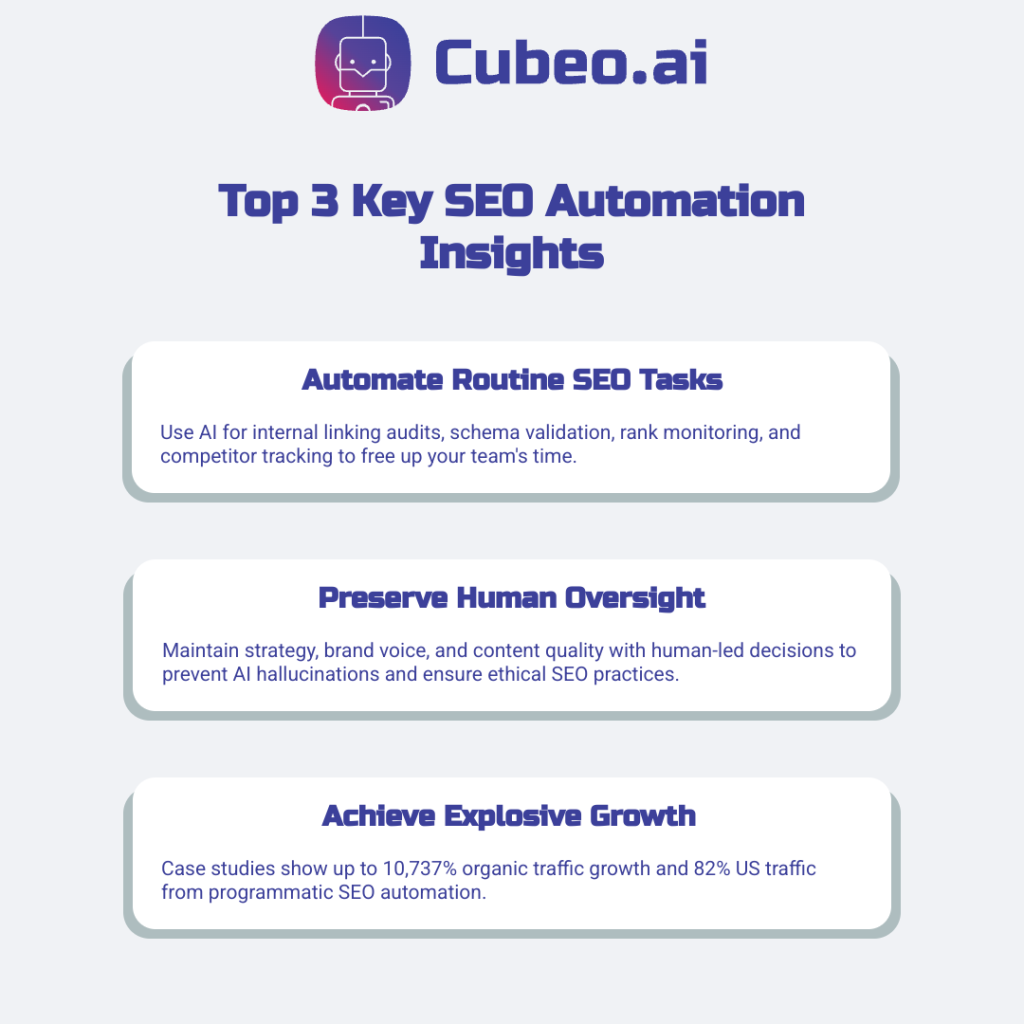This guide is for SEO practitioners and Content Ops managers who understand fundamentals but don’t have engineering skills to orchestrate AI models. You’ll get hands-on checklists, exact Triggers to start with and KPI targets.
You can pilot a measurable workflow that reclaims your team’s time for strategy work instead of routine tasks.
What SEO Automation Really Means and Where It Applies
Most SEO teams are drowning in manual tasks that machines could handle better. SEO automation means using AI agents, workflow and triggers to handle repetitive, data heavy SEO tasks. Think internal linking audits, schema markup validation, rank monitoring and competitor tracking.
SEO.com’s 2025 AI adoption report shows 84% of marketers use AI for aligning content with search intent. The technology excels at processing large datasets and executing rule-based decisions at scale.
This differs from full content generation. Automation handles structure and data analysis. Humans handle strategy, brand voice and creative decisions. The goal is freeing your team from busywork, not replacing expertise.
Where Automation Excels and Where Humans Must Lead
Automation thrives on repetitive tasks, data analysis, real-time monitoring, and structural consistency. AI can scan thousands of pages for broken links, suggest schema improvements, and track ranking changes across hundreds of keywords.
Human judgment remains essential for content quality, brand voice, strategic decisions, and ethical oversight. AI can flag broken links and suggest replacements, but you decide which links align with your content strategy.
SEO.com’s automation guidance emphasizes that human oversight remains critical for strategy and quality control. This prevents hallucination (AI inventing facts) and maintains brand integrity.
The Stakes for Practitioners in 2025
If your team still spends hours weekly on audits and reports, you’re falling behind and missing refresh cycles competitors automate. Structure content for Google and LEO (LLM optimized content with clear H2s, citations, schema) so both search engines and LLMs (large language models like ChatGPT) can find and cite your pages.
SEO automation case studies show companies like Flyhomes achieving 10,737% organic traffic growth after automating content production and topic-cluster scaling, while KrispCall generated 82% of U.S. traffic from programmatic SEO.
The opportunity is clear: improve consistency, reduce manual overhead and optimize for both traditional search engines and AI-powered discovery platforms.

Building Your Agentic SEO Automation Workflow Step by Step
Here’s your blueprint for a production-ready agentic SEO pipeline. Each agent owns specific KPIs, every workflow includes human checkpoints and Triggers automate the entire system based on real-time signals.
Discover Keywords and Assign Agent Roles
Deploy a Keyword Research Agent to pull opportunities from your target market. This AI agent analyzes search data and competitor gaps autonomously.
Agent Owner: Keyword Research Agent — Metrics: Difficulty scores, search volume — Cadence: Weekly — Reviewer: SEO Lead — SLA: 24 hours
Checklist:
- Target keywords with difficulty <30 and volume >1,000
- Map to user intent (informational, commercial, transactional)
- Export to brief template with priority rankings
Generate LEO-Ready Briefs Automatically
Assign your Brief Generator Agent to create outlines with H2/H3 hierarchy, target keywords, and LEO checklists. Export briefs flagged “LEO OK” to your Content Agent.
Agent Owner: Brief Generator — Metrics: Header compliance, meta completion, alt text coverage — Cadence: Per brief — Reviewer: Content Manager — SLA: 48 hours
Checklist:
- Validate against LEO requirements (clear H2s, citations, schema)
- Keep keyword density between 1-2% (starting recommendation)
- Export structured briefs to content queue
Automating Agent Triggers
Once your agents are active, you can set simple rules (triggers) that tell them when to start working.
For example, you might trigger an action when your keyword rankings drop, impressions fall, or a competitor updates their site. Start small and set conservative conditions first (like a 15% change). Adjust as you learn what signals really matter.
Each action should leave a clear record of what changed and why, so you can always track what your system did.
If the data isn’t reliable, the workflow should stop and ask for human review before continuing.
Checklist:
- Define what events should activate each agent (rank changes, competitor updates, or CRM data shifts).
- Send notifications to your team automatically in Slack or email when something needs review.
- Keep reliability high. Aim for fewer than 15% failed or unclear runs before it’s ready for full rollout.
Keeping Humans in the Loop
Automation doesn’t replace expertise, it multiplies it.
Every agent should have human checkpoints where someone reviews outputs before publishing or major updates.
This keeps accuracy high and ensures AI stays aligned with your goals and brand voice.
Checklist:
- Assign reviewers for each stage of your workflow (research, brief, content).
- Define measurable KPIs for every agent — like keyword ranking accuracy, LEO compliance, or citation quality.
- Use dashboards to track performance trends and trigger alerts when KPIs drop below target.
When done right, teams see up to 30% traffic growth and 40% less manual work, simply by combining automation with structured human review.

FAQ
What SEO tasks can be fully automated with AI agents?
AI agents can fully automate a significant range of SEO tasks, transforming how businesses approach digital visibility. These powerful tools excel at data-heavy processes, from comprehensive keyword research and analysis to drafting SEO-optimized content outlines and performing technical site audits.
Beyond initial content creation and keyword identification, AI agents can continuously monitor real-time performance, track keyword rankings, and suggest content optimizations. They also streamline SEO reporting by generating dashboards and alerts for critical metrics like impressions and clicks. This level of automation allows teams to shift focus from tedious, repetitive tasks to strategic oversight and innovation, ensuring that the technical excellence of SEO is maintained while freeing up human potential for more complex problem-solving.
Is it better to build or buy an AI agent platform for SEO?
The decision to build or buy an AI agent platform for SEO hinges on your strategic priorities, unique business needs, and available resources. Buying a pre-built platform offers immediate access to existing tools, allowing for rapid validation of AI’s impact on your SEO efforts without a substantial upfront investment in development.
However, for organizations with highly differentiated needs or stringent control requirements, building a custom AI agent platform can provide a unique competitive advantage. While it demands a higher initial investment in infrastructure and development, a custom solution ensures a tailored fit, proprietary data integration, and the flexibility to evolve with your specific business model. A hybrid approach, where core, high-impact agents are built in house and non-core functions leverage vendor solutions, often strikes a pragmatic balance, combining the best of both worlds to achieve scalable and secure production-ready solutions.
How do I ensure my automated SEO content ranks on both Google and ChatGPT?
To ensure your automated SEO content ranks effectively on both Google and generative AI platforms like ChatGPT, a dual-focused strategy is essential, blending traditional SEO rigor with optimization for AI’s unique processing. Start with strong SEO fundamentals: meticulous keyword research, technical optimization and a well-structured content architecture that Google’s algorithms favor.
Crucially, since ChatGPT often leverages Bing for its search needs, optimizing for Bing becomes a significant factor. Beyond technicalities, focus on creating content that demonstrates genuine expertise, experience, authoritativeness, and trustworthiness (E-E-A T), as AI systems prioritize credible and clear communication. This means crafting content that not only answers questions directly but also provides comprehensive, problem-solving insights. For local businesses, optimizing listings on platforms like Google Business Profile and Bing Places further enhances visibility across both traditional search and AI-driven results, ensuring your automated content is not just discoverable but also cited as a reliable source.



